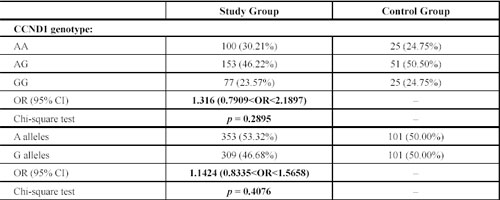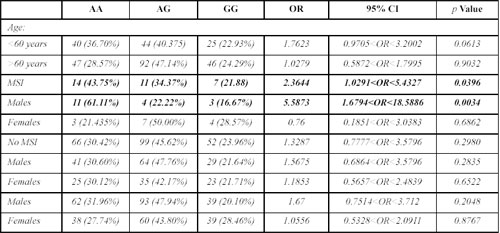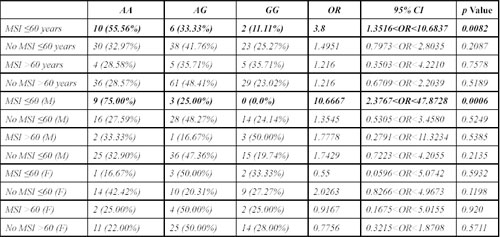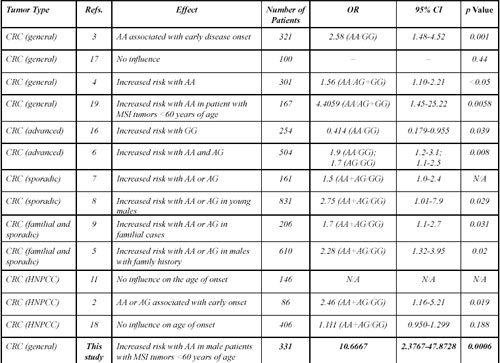


CYCLIN D1 G870A VARIANT IS ASSOCIATED WITH
INCREASED RISK OF MICROSATELLITE INSTABILITY-POSITIVE COLORECTAL CANCER IN YOUNG MALE PATIENTS
Josifovski T2*, Matevska N1*, Hiljadnikova-Bajro M1, Sterjev Z1,Kapedanovska A1, Serafimoska Z1, Despotovska S1, PetrusevskaN3,
Panovski M2, Suturkova L1, Dimovski AJ1
*Corresponding Author: Corresponding Author: Aleksandar J. Dimovski, Ph.D., Institute of Pharmaceutical Chemistry,
Faculty of Pharmacy, University Ss Cyril and Methodius, Skopje 1000, Republic of Macedonia;
Tel.: +389-2-3217-580; Fax: +389-2-3290-830; E-mail: adimovski@ff.ukim.edu.mk
page: 29
|
|
DISCUSSION
Although the molecular basis of HNPCC is well known, there is no explanation for the wide range of phenotypes observed, e.g., the wide variety in age of onset (19-90 years) of CRC. Thus, other environmental or genetic factors must be considered as modifying the HNPCC phenotype. The first genetic modifier reported to be associated with age of onset in HNPCC was the CCND1 G870A polymorphism [2,3], but other studies failed to detect any significant association in a larger HNPCC population [11,18] (Table 5).
Table 2. Allele frequencies and genotype distribution of CCND1 G870A in colorectal cancer patients and controls.

Data are numbers with percentages in parentheses unless otherwise indicated OR = Odds Ratio CI = Confidence Interval
Table 3. Correlation of the CCND1 genotype with some clinicopathological parameters (study group).

Data are numbers with percentages in parentheses OR = Odds Ratio CI = Confidence Interval
We correlated the CCND1 G870A polymorphism with MSI status of the tumors and observed a statistically significant risk of CRC in MSI-positive carriers of the CCND1 A allele. After stratification by gender and age at diagnosis, we observed increased risk in male patients and particularly those under 60 years of age, as indicated by the increase of the ORs. The consequences of the above observation were reversed (although statistically not significant) in female patients (Tables 3 and 4). The effect of the CCND1 A allele on the risk of CRC apparently differs by gender which could be ex plained by the sex hormone divergence. The CCND1 870A variant may enhance CRC progression through a cell signalling pathway influenced by estrogens in colonic epithelia. It is well known that induction of cyclin D1 gene transcription by estrogen receptor a (ERa) plays an important role in estrogen-mediated proliferation in breast cancer [21,22]. However, estrogens decrease cyclin D1 gene expression when they bind to ERa. Strikingly, the presence of ERb completely inhibits cyclin D1 gene activation by estrogen and ERb, and even has the ability to block estrogen activation of the cyclin D1 gene mediated by ERb if the two receptors are present in the same cell [23], and seems to be essential for maintenance of cellular homeostasis and for driving cellular differentiation in the colon [24,25].
Table 4. Association of the CCND1 genotype with colorectal cancer risk stratified by age, gender and microsatellite instability status of the tumors (study group).

Data are numbers with percentages in parentheses OR = Odds Ratio CI = Confidence Interval
Table 5. Comparison of the effect of the CCND1 G870A polymorphism on colorectal cancer in several published studies.

The fact that ERa, the predominant ER subtype in the human colon, is significantly decreased in CRCs compared with normal mucosa, led to our assumption that estrogen has a protective role in the regulation of colon tumor growth and CRC development. Indeed, the risk of both CRC and adenoma associated with a family history of CRC may be augmented by the CCND1 G870A genotype [5]. Moreover, the A870G genotype appears to enhance the protective effect of postmenopausal estrogen use on the development of colorectal neoplasia, whereas there was no effect of postmenopausal hormone use among those with the GG genotype [5]. Our findings led us to conclude that the CCND1 AA genotype may have a modifying effect in decreasing the age of onset in HNPCC, but only in males since they lack the protective effect of estrogen. If these results can be replicated in other case/control studies, the CCND1 G870A variant could be used in the future to provide additional information in genetic counseling of families with MSI-positive tumors.
|
|
|
|



 |
Number 27
VOL. 27 (2), 2024 |
Number 27
VOL. 27 (1), 2024 |
Number 26
Number 26 VOL. 26(2), 2023 All in one |
Number 26
VOL. 26(2), 2023 |
Number 26
VOL. 26, 2023 Supplement |
Number 26
VOL. 26(1), 2023 |
Number 25
VOL. 25(2), 2022 |
Number 25
VOL. 25 (1), 2022 |
Number 24
VOL. 24(2), 2021 |
Number 24
VOL. 24(1), 2021 |
Number 23
VOL. 23(2), 2020 |
Number 22
VOL. 22(2), 2019 |
Number 22
VOL. 22(1), 2019 |
Number 22
VOL. 22, 2019 Supplement |
Number 21
VOL. 21(2), 2018 |
Number 21
VOL. 21 (1), 2018 |
Number 21
VOL. 21, 2018 Supplement |
Number 20
VOL. 20 (2), 2017 |
Number 20
VOL. 20 (1), 2017 |
Number 19
VOL. 19 (2), 2016 |
Number 19
VOL. 19 (1), 2016 |
Number 18
VOL. 18 (2), 2015 |
Number 18
VOL. 18 (1), 2015 |
Number 17
VOL. 17 (2), 2014 |
Number 17
VOL. 17 (1), 2014 |
Number 16
VOL. 16 (2), 2013 |
Number 16
VOL. 16 (1), 2013 |
Number 15
VOL. 15 (2), 2012 |
Number 15
VOL. 15, 2012 Supplement |
Number 15
Vol. 15 (1), 2012 |
Number 14
14 - Vol. 14 (2), 2011 |
Number 14
The 9th Balkan Congress of Medical Genetics |
Number 14
14 - Vol. 14 (1), 2011 |
Number 13
Vol. 13 (2), 2010 |
Number 13
Vol.13 (1), 2010 |
Number 12
Vol.12 (2), 2009 |
Number 12
Vol.12 (1), 2009 |
Number 11
Vol.11 (2),2008 |
Number 11
Vol.11 (1),2008 |
Number 10
Vol.10 (2), 2007 |
Number 10
10 (1),2007 |
Number 9
1&2, 2006 |
Number 9
3&4, 2006 |
Number 8
1&2, 2005 |
Number 8
3&4, 2004 |
Number 7
1&2, 2004 |
Number 6
3&4, 2003 |
Number 6
1&2, 2003 |
Number 5
3&4, 2002 |
Number 5
1&2, 2002 |
Number 4
Vol.3 (4), 2000 |
Number 4
Vol.2 (4), 1999 |
Number 4
Vol.1 (4), 1998 |
Number 4
3&4, 2001 |
Number 4
1&2, 2001 |
Number 3
Vol.3 (3), 2000 |
Number 3
Vol.2 (3), 1999 |
Number 3
Vol.1 (3), 1998 |
Number 2
Vol.3(2), 2000 |
Number 2
Vol.1 (2), 1998 |
Number 2
Vol.2 (2), 1999 |
Number 1
Vol.3 (1), 2000 |
Number 1
Vol.2 (1), 1999 |
Number 1
Vol.1 (1), 1998 |
|
|

